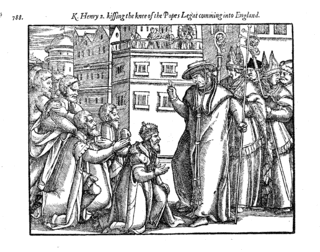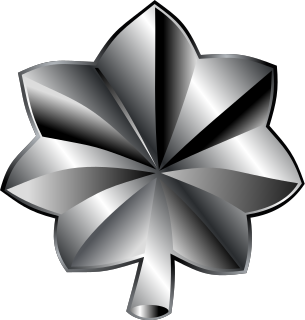In linear algebra, the rank of a matrix A is the dimension of the vector space generated by its columns. This corresponds to the maximal number of linearly independent columns of A. This, in turn, is identical to the dimension of the vector space spanned by its rows. Rank is thus a measure of the "nondegenerateness" of the system of linear equations and linear transformation encoded by A. There are multiple equivalent definitions of rank. A matrix's rank is one of its most fundamental characteristics.
A marquess is a nobleman of high hereditary rank in various European peerages and in those of some of their former colonies. The term is also used to translate equivalent Asian styles, as in Imperial China and Imperial Japan. The German language equivalent is Markgraf (Margrave).
In biological classification, the order is
- a taxonomic rank used in the classification of organisms and recognized by the nomenclature codes. Other well-known ranks are life, domain, kingdom, phylum, class, family, genus, and species, with order fitting in between class and family. An immediately higher rank, superorder, may be added directly above order, while suborder would be a lower rank.
- a taxonomic unit, a taxon, in that rank. In that case the plural is orders.
In biological classification, a subfamily is an auxiliary (intermediate) taxonomic rank, next below family but more inclusive than genus. Standard nomenclature rules end subfamily botanical names with "-oideae", and zoological names with "-inae".
A constable is a person holding a particular office, most commonly in criminal law enforcement. The office of constable can vary significantly in different jurisdictions. A constable is commonly the rank of an officer within the police. Other people may be granted powers of a constable without holding this title.
A lieutenant is a junior commissioned officer in the armed forces, fire services, police and other organizations of many nations.

In biological classification, the term subspecies refers to one of two or more populations of a species living in different subdivisions of the species' range and varying from one another by morphological characteristics. A single subspecies cannot be recognized independently: a species is either recognized as having no subspecies at all or at least two, including any that are extinct. The term may be abbreviated to subsp. or ssp. The plural is the same as the singular: subspecies.

Sergeant is a rank in many uniformed organizations, principally military and policing forces. The alternative spelling, serjeant, is used in The Rifles and other units that draw their heritage from the British light infantry. Its origin is the Latin serviens, 'one who serves', through the French term sergent.

In statistics, Spearman's rank correlation coefficient or Spearman's ρ, named after Charles Spearman and often denoted by the Greek letter (rho) or as , is a nonparametric measure of rank correlation. It assesses how well the relationship between two variables can be described using a monotonic function.
A chief petty officer is a senior non-commissioned officer in many navies and coast guards.

A papal legate or apostolic legate is a personal representative of the pope to foreign nations, or to some part of the Catholic Church. He is empowered on matters of Catholic faith and for the settlement of ecclesiastical matters.
Naik is the Indian Army and Pakistan Army rank equivalent to corporal. In Tamil, the word naik was used to indicate a lord or governor prior to its use as an equivalent to corporal in British India.

The Philidor position usually refers to an important chess endgame which illustrates a drawing technique when the defender has a king and rook versus a king, rook, and a pawn, though it can also refer to a position in the queen versus rook endgame or a position in a rook and bishop versus rook endgame. In the case of a rook and pawn versus a rook, it is also known as the third rank defense, because of the importance of the rook on the third rank cutting off the opposing king. It was analyzed by François-André Danican Philidor in 1777. Many rook and pawn versus rook endgames reach either the Philidor position or the Lucena position. If played accurately the defending side tries to reach the Philidor position; the other side tries to reach the winning Lucena position. Some consider this to be one of the most important positions in endgame theory".
In many of the world's military establishments, a brevet was a warrant giving a commissioned officer a higher rank title as a reward for gallantry or meritorious conduct but may not confer the authority, precedence, or pay of real rank. An officer so promoted was referred to as being brevetted. The promotion would be noted in the officer's title.

In the United States Army, U.S. Marine Corps, U.S. Air Force and U.S. Space Force, lieutenant colonel is a field grade officer rank, just above the rank of major and just below the rank of colonel. It is equivalent to the naval rank of commander in the other uniformed services.

In biological classification, taxonomic rank is the relative level of a group of organisms in a taxonomic hierarchy. Examples of taxonomic ranks are species, genus, family, order, class, phylum, kingdom, domain, etc.
Nakoleia, Latinized as Nacolia or Nacolea, was an ancient and medieval city in Phrygia. It corresponds to present-day Seyitgazi, Eskişehir Province in the Central Anatolia region of Turkey.
An envoy extraordinary and minister plenipotentiary, usually known as a minister, was a diplomatic head of mission who was ranked below ambassador. A diplomatic mission headed by an envoy was known as a legation rather than an embassy. Under the system of diplomatic ranks established by the Congress of Vienna (1815), an envoy was a diplomat of the second class who had plenipotentiary powers, i.e., full authority to represent the government. However, envoys did not serve as the personal representative of their country's head of state. Until the first decades of the 20th century, most diplomatic missions were legations headed by diplomats of the envoy rank. Ambassadors were only exchanged between great powers, close allies, and related monarchies.

Precedence signifies the right to enjoy a prerogative of honor before other persons; for example, to have the most distinguished place in a procession, a ceremony, or an assembly, to have the right to express an opinion, cast a vote, or append a signature before others, to perform the most honorable offices.
The Military ranks of the Italian Social Republic were the military insignia used by the Italian Armed Forces of the Italian Social Republic. The ranks were essentially the same as the Military ranks of the Kingdom of Italy, however, with the symbols of the monarchy removed.







